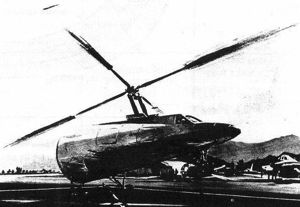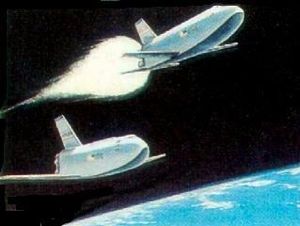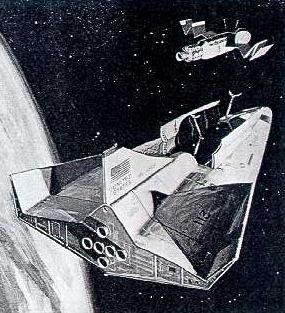
Home - Search - Browse - Alphabetic Index: 0- 1- 2- 3- 4- 5- 6- 7- 8- 9
A- B- C- D- E- F- G- H- I- J- K- L- M- N- O- P- Q- R- S- T- U- V- W- X- Y- Z
Shuttle NAR A

Shuttle NAR A
Credit: NASA
Status: Study 1969. Thrust: 24,948.00 kN (5,608,533 lbf). Gross mass: 2,036,734 kg (4,490,229 lb). Height: 102.00 m (334.00 ft). Diameter: 9.88 m (32.41 ft).
Faget disliked the Lockheed Starclipper and other lifting-body designs since they had poor low-speed handling characteristics and would be difficult to develop since the structure was tightly coupled with the aerodynamics. Faget preferred a simple winged design. His solution was dubbed the 'DC-3' and sought to alleviate the problem of re-entering at a 60 deg angle of attack, essentially accomplishing a ballistic re-entry like an Apollo capsule. This would only expose the flat underside of the vehicle to high heating rates, as most of the thermal energy would go into the shock wave forming in front of the vehicle. The high drag also shortened the duration of the heat pulse, yet did not exceed acceptable crew deceleration load factors beyond 2 g's.
The DC-3 wing would only be optimized for subsonic flight and landing. But the low lift-to-drag ratio re-entry profile advocated by Faget would limit the DC-3's cross range to 430 km, far less than the USAF requirement.
The gross lift-off mass of North America's elaboration of Faget's concept was 2,030,000 kg. Both booster and orbiter would be towed horizontally to the launch complex, and be lifted vertically and mated on the pad.
The booster was 85.4 m long, with a 2219-Al aluminum structure, with a thermal protection system consisting of Lockheed LI-1500 tiles with a density of 63 kg/sq m. The wing had a span of 74.4 m and was built of 6A1-4V titanium. 11 x 230,000 kgf Rocketdyne Lox/LH2 engine provided boost at lift-off. 4 x JT9D-15 turbojet engines, fed by 26,200 kg of fuel, provided a 500 km cruise back range. The booster was unmanned during space missions, but there were provisions for two crew to fly the aircraft during ferry flights.
The orbiter was 61.6 m long, and had a 263 sq m wing with a span of 44.5 m. Two crew plus ten passengers could be accommodated in the orbiter, plus 5,580 kg cargo in a 4.6 m x 18.3 m payload bay. The orbiter was equipped with 2 x 231,000 kgf Rocketdyne Lox/LH2 engines. It was anticipated that improved engines would increase the rated payload to orbit by 4500 kg. For atmospheric cruise, 4 x JT3D-7 jet engines, rated at 8600 kgf each, were mounted in nacelles on the upper wing surface. Internally, the payload bay was placed at the center of gravity, with the two liquid hydrogen tanks aft, and the liquid oxygen tank forward. The propellant tanks were suspended within the orbiter structure and made of 2219-Al aluminum. The structure was built of 6A1-5V titanium, and the thermal protection system consisted of LI-1500 tiles (with a density of 63 kg/sq m), developed by Lockheed. The orbiter would separate from the booster at 61 km altitude and 3,300 m/sec velocity. The orbiter's main engines would fire until the spacecraft was placed in a minimum 92 x 185 km orbit. It was expected that orbital operations - circularization, rendezvous and docking with a space station in a 480 km circular orbit, deorbit - would take 370 m/sec delta-V. The orbiter was designed to accomplish a total 600 m/sec delta-v - a 60% margin. Expected re-entry heating rates on the orbiter were 1650 deg C on the leading edge, and 790 deg C over 80% of the lower surface.
North American estimated their space launcher would take 4.5 years to develop and productionize, at a cost under the $5.912 billion ceiling set by Faget. In order to fly 50 missions per year, it was estimated that six vehicles would be required, together with 200 maintenance staff.
Stage Data - Shuttle NAR A
- Stage 1. 1 x Shuttle NAR A-1. Gross Mass: 1,641,723 kg (3,619,379 lb). Empty Mass: 273,469 kg (602,895 lb). Thrust (vac): 28,130.189 kN (6,323,918 lbf). Isp: 442 sec. Burn time: 208 sec. Isp(sl): 392 sec. Diameter: 9.88 m (32.41 ft). Span: 74.39 m (244.06 ft). Length: 85.37 m (280.08 ft). Propellants: Lox/LH2. No Engines: 11. Engine: SSME Study. Status: Study 1969 December. Comments: Faget Straight Wing Configuration.
- Stage 2. 1 x Shuttle NAR A-2. Gross Mass: 395,011 kg (870,850 lb). Empty Mass: 121,542 kg (267,954 lb). Thrust (vac): 5,256.893 kN (1,181,797 lbf). Isp: 459 sec. Burn time: 231 sec. Isp(sl): 359 sec. Diameter: 6.71 m (22.01 ft). Span: 44.51 m (146.03 ft). Length: 61.59 m (202.06 ft). Propellants: Lox/LH2. No Engines: 2. Engine: SSME Study. Status: Study 1969 December. Comments: Faget Straight Wing Configuration - Cross Range 2,000 km.
Family: orbital launch vehicle, Winged. Country: USA. Engines: SSME Study. Stages: Shuttle NAR A-1, Shuttle NAR A-2. Agency: North American.
 | Shuttle NAR A Credit: NASA |
 | Shuttle NAR A DC-3 booster / orbiter stage separation at 70km altitude. Credit: NASA |
 | Shuttle NAR A Credit: NASA |
Back to top of page
Home - Search - Browse - Alphabetic Index: 0- 1- 2- 3- 4- 5- 6- 7- 8- 9
A- B- C- D- E- F- G- H- I- J- K- L- M- N- O- P- Q- R- S- T- U- V- W- X- Y- Z
© 1997-2019 Mark Wade - Contact
© / Conditions for Use